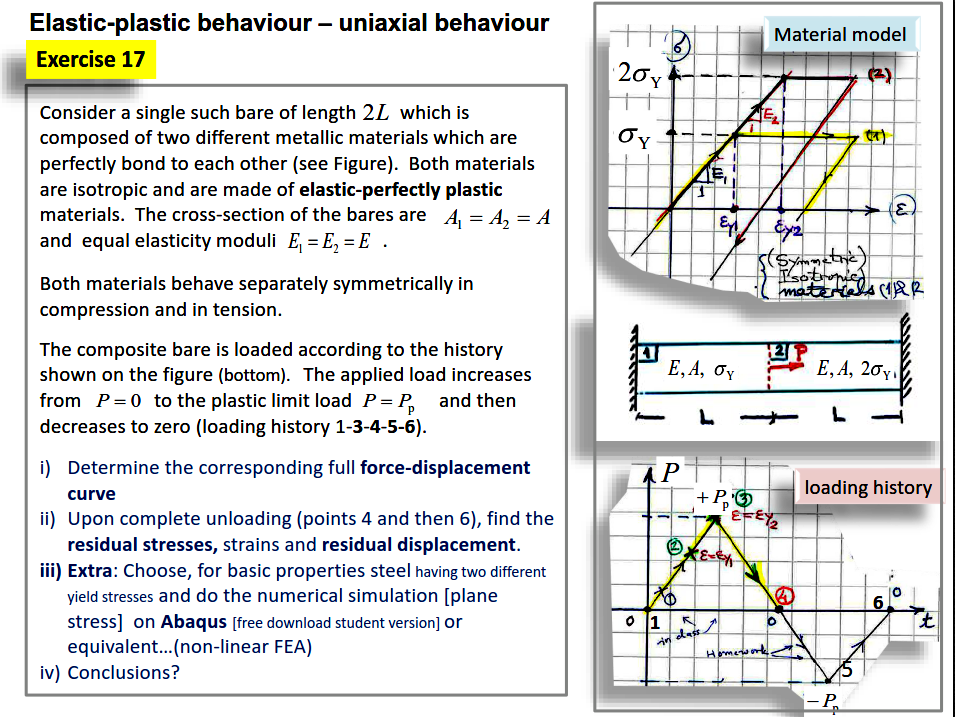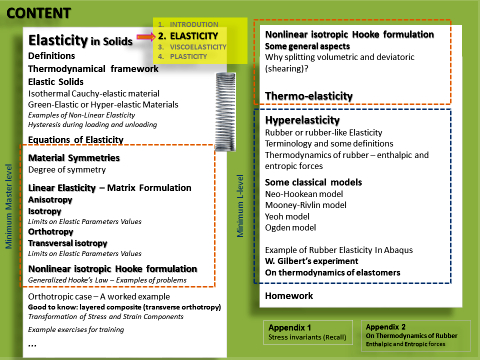CIV-E4080 - Material Modelling in Civil Engineering D, Lecture, 24.4.2023-7.6.2023
This course space end date is set to 07.06.2023 Search Courses: CIV-E4080
Topic outline
-
Teacher
Djebar BAROUDI, Phd.
CONTENT [pdf: https://mycourses.aalto.fi/pluginfile.php/1764937/course/section/224610/CONTENT_1_ELASTICITY_2_VISCOELASTICITY_3_Plasticity_Content--2019.pdf]
MECHANICAL CONSTITUTIVE MODELS
• ELASTICITY … linear, hyper-elasticity, non-linear, isotropy, transverse isotropy, anisotropy, orthotropy
• VISCOELASTICITY
• VISCOPLASTICITY … (creep - basics only)
• PLASTICITY ... associative, non-associative
• Damage … this year 2019: Modeling quasi-brittle behaviour - Adj Prof. Timo SAKSALA.
For the detailed content, see at the end of this list.

Comparison of two courses content: this course at Aalto and equivalent course at Technische Universität Darmstat

--------------------------------------------------------------------
************************************************************************* *************************************************************************weekly: two SUCCESSIVE LECTURES followed by two successive exercise cessions.
Weekly teaching sequence is LLEE, (L = Lectures & E = Guided Exercises and HW).
However, depending on force-majeure situations and of our progress in going through the lecture material, this sequence can evolve. For example an other possible combination can be LLLE.Main Textbooks for the current course
Not the whole books but chosen chapters
• [1] Mechanics of Solid Materials. Jean Lemaitre, Université de Paris VI (Pierre et Marie Curie) & Jean-Louis Chaboche, 1994. Cambridge Univ. Press.
(Main Textbook 1, the relevant chapters and reading assignements are given during the lectures)
Lemaitre & Chaboche textkook as an e-book:
• [2] Plasticity for Structural Engineers . Wai Fah Chen, D.J. Han, Springer New York, 6 Dec 2012. (Chapters 1-5 for the engineering plasticity-part of our course … content well oriented for structural Engineers)
Recommended reading
• [3] The Mechanics of Constitutive Modeling
Niels Saabye Ottosen and Matti Ristinmaa, 2005. Elsivier
• [4] Plasticity Theory (textbook, e-book too). Jacob Lubliner.(Some official released free old versions can be found in the internet).
• [5] Kenneth Runesson – The Primer - Constitutive modelling of engineering materials. This covers in details the entire scopes of our course.• [6] Reijo Kouhia – Brief Introduction to continuum mechanics. A concise reading - 100 pp.• [7] Continuum Mechanics: Elasticity, Plasticity, ViscoelasticityEllis H. Dill, November 10, 2006 by CRC Press (a complete textbook, I warmaly recomand it)
- [8] Simo, J.C. and Hughes, T.J.R. (1998): ”Computational Inelasticity”, Springer Verlag, New York, Inc.
• [9] BRUNET Michel. MECANIQUE DES MATERIAUX ET DES STRUCTURES (Master course Lecture-notes: chapters 3, 4 and 5 correspond well to the content of our course) [in French] INSTITUT NATIONAL DES SCIENCES APPLIQUEES DE LYON, 2012. (https://mycourses.aalto.fi/pluginfile.php/1764937/course/section/224610/Lecture_Notes_MECANIQUE_des_Structures_et_Materiaux%20-%20INSA-Lyon--FR.pdf)• [10] Eero-Matti Salonen. Teknillisen korkeakoulun mekaniikan emeritusprofessorin Mekaniikan käsitteitä ja kaavoja, 1987. Monumentaalinen teos sisältää > 800 sivua ja käsittelee sekä kiinteän että nesteen mekaniikkaa. (pdf: https://mycourses.aalto.fi/pluginfile.php/1764937/course/section/224610/00_Book_mekaniikan_kaavoja_kasitteita_salonen_luvut_all.pdf (80 Mb , lataus kestänee...)
• [11] http://solidmechanics.org/index.html (a must site to know ...)
This electronic material summarizing: physical laws, mathematical models, and algorithms that are used to predict the response of materials and structures to mechanical or thermal loading.
************************************************************************* *************************************************************************About the course supporting Material
• In addition to the pointed chapters from the course textbooks for each topic, I will provide an additional learning/reading supporting material together with weekly homework series (3-6 exercises/week. Each exercise is marked (arvosana) 0-5 if not otherwise stated in the homework-paper).
• The Lecturer's written material is not a collection of lecture-slides but it is a pedagogical material offered to help and motivate students in their reading the chosen subject from the course textbooks & elsewhere.
Lecture slides cannot capture the dynamics of the in-vivo lecture nor the content of a good textbook..
• The topics treated in this intensive course cannot be avoided by future structural engineers: these topics will wait for them hidden, inside the FE-software you will use to perform structural analysis, in the black-boxes called material models. This course is may be the right place for first meeting them in a friendly learning environment and opening these black-boxes ...
Generalities
https://mycourses.aalto.fi/pluginfile.php/1764937/course/section/224610/Passing_2019.jpg


As an illustration of how useful can be the knowledge of particular material behavior law, below is shown a fresh research example. The question was to find the basic mechanisms involved in the formation of a global primary early crack pattern which are observed on the surface of wood and wood-like specimens (MDF) resulting from surface heating.
In this journal publication, for the first time, the driving thermo-mechanical mechanisms behind such organization of patterns were identified. It was shown that, on the contrary of what was believed till now, they do not result from shrinkage for temperatures below the pyrolysis temperature. If shrinkage was the driving mechanisms during initial surface heating then the cracks would form parallel to the fibers - the weakest direction for strength - in the orthotropic natural wood sample (subfigures on right). However during the experiments the cracks form orthogonally to the strongest strength direction (perpendicular to fibers) at the same time not sequentially.
Above pyrolysis temperatures, shrinkage becomes probably dominant after the softened hot 'film' has hardened due to various chemico-physical reactions. However, many 'interesting' phenomena may still occur below such pyrolysis temperature region.
The conclusion of our work relies strongly on observations, interdisciplinary knowledge of the material wood as a natural thermoplastic and the resulting thermo-mechanical behavior together linked with strong basis from the old-time Structural Mechanics.
--------------------------------------------------------
Part of the results published in:
========================
The content of the course is the folowing:



=================================================
Content of the supporting pdf-material
0. INTRODUTION
1. ELASTICITY
2. VISCOELASTICITY (& some basics of creep)
3. PLASTICITY (& Failure Hypotheses )
[NB]. If you are not enrolled in this course and you wish to obtain the pdf-material, please let me know by contacting me
// NB. The topics treated in this intensive course are of great practical importance and cannot be avoided by serious & responsible future structural engineers: in any case, these topics will wait for them hidden inside the FE-software they will use to perform structural analysis. Isn't this course the right place for the 1st contact? //
==========================================
Generalities
There will be three sets of homework
1. Elasticity
2. Viscoelasticity
3. Plasticity
Please remember: doing actively the given homework is the only active and effective mean for learning and consolidating concepts that CIV-students should know and handle surely. Such concepts are exposed during the lectures.
--------------------------------------------------------------------
About the course supporting Material
• In addition to the pointed chapters from the course textbooks for each topic, I will provide an additional learning/reading supporting material together with weekly homework series (3-6 exercises/week. Each exercise is marked (arvosana) 0-5 if not otherwise stated in the homework-paper).
• The Lecturer's written material is not a collection of lecture-slides but it is a pedagogical material offered to help and motivate students in their reading the chosen subject from the course textbooks & elsewhere.
Lecture slides cannot capture the dynamics of the in-vivo lecture.
• The topics treated in this intensive course cannot be avoided by future structural engineers: these topics will wait for them hidden, inside the FE-software you will use to perform structural analysis, in the black-boxes called material models. This course is may be the right place for first meeting them in a friendly learning environment and opening these black-boxes ...
====== END
- [8] Simo, J.C. and Hughes, T.J.R. (1998): ”Computational Inelasticity”, Springer Verlag, New York, Inc.
